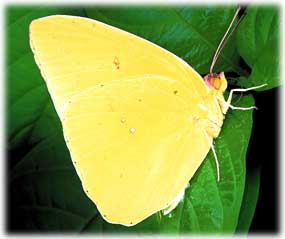

The cloudless sulphur is a large yellow butterfly with a fast, powerful fight. Males are virtually solid yellow above and below and have few visible markings. Females may be yellow, orange-yellow or white, and they have a faint dark border on the upper surface of their wings. Although a common year-round resident in much of peninsular Florida, the cloudless sulphur rapidly extends it range northward each spring and eventually establishes breeding colonies as far north as Canada and the Midwest by the end of summer. As cool autumn weather approaches, adults from the final generation begin a return migration, coming back to the Deep South to overwinter.
The whitish yellow elongated eggs are deposited singly on the leaves of the host plants. The long, slender caterpillar may be green or yellow. It has a narrow yellow stripe down each side and is covered with numerous small black bumps or tubercles. When not feeding, larvae rest exposed on the surface of host leaves.